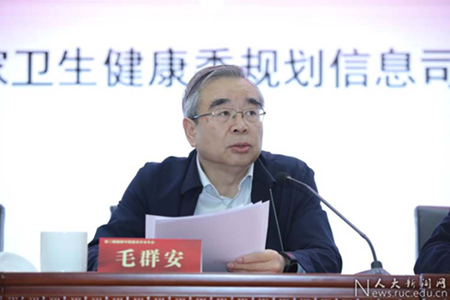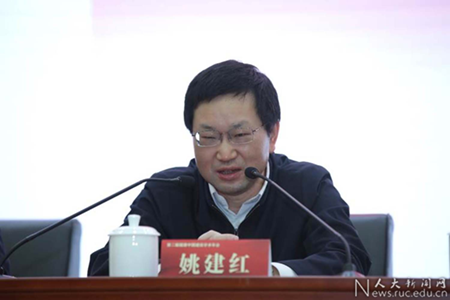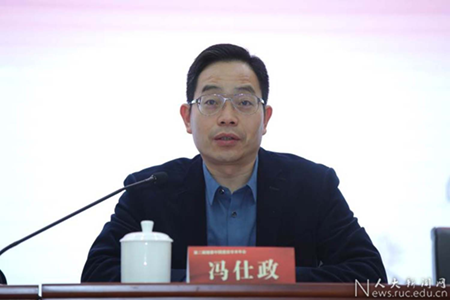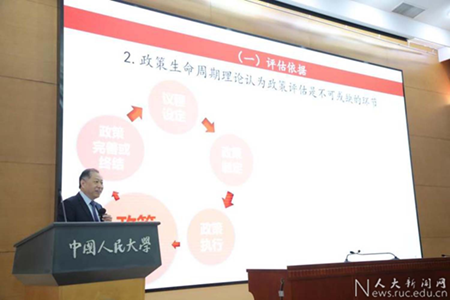Entitled “Jointly Building a Healthy China and Optimizing Health Management”, the second Academic Annual Conference on Building a Healthy China was held in Renmin University of China (RUC) on Dec. 17th.
The conference was guided by the Healthy China Initiative Leading Group of the National Health Commission (NHC), and hosted by the Research Center for Health and Medical System Reform and Development of RUC and China Population and Develop Research Center. Sun Baiying, Deputy Dean of the School of Public Administration and Policy of RUC, presided over the opening ceremony.

Representing Yu Xuejun, Deputy Director of the NHC, Mao Qunan, Director of the Department of Planning, Development and Informatization of NHC, made remarks in the opening ceremony. Several organizations and departments, experts and scholars have deeply engaged in the practice of building a healthy China, he said. RUC, as the representative among all the universities and research institutions, has actively participated in the training of high-level talents, carried out academic activities, and achieved obvious social effects.

Zhu Hongbiao, Vice President of the China Health Economics Association, said that the 20th National Congress of CPC has pointed out the direction of the Chinese healthcare business, and the China Health Economics Association is willing to cooperate to build a Healthy China.

Yao Jianhong, Secretary of the Party Committee of Peking Union Medical College, stressed the necessity to understand and explain the connotation of medical theories and the importance of promoting institutional innovation. In the future, he said, Peking Union Medical College will strengthen exchanges and cooperation with universities to provide the technical and spiritual impetus for a Healthy China.

Feng Shizheng, Vice President of RUC, introduced the actions RUC took in a Healthy China. RUC has played an important role in talent security, and intellectual and theoretical support, he said. In the future, RUC will contribute more to the development of a Healthy China and make unremitting efforts to promote the cause of human health.

In her concluding speech, Sun Baiying said that 2023 is a key year in the “14th Five-Year Plan”. In this crucial period, it is of great practical significance for us to meet to hold the conference.

After the opening ceremony, the video of the “2023 Healthy China Initiative and Resident Participation and Evaluation Report” was played. Wang Hufeng, Vice President of the China Health Economics Association, made a speech on the report.
He pointed out that the inter-ministerial coordination has been continuously improved, and the 15 special projects are well-progressed. The sample survey shows that the residents have a high-level awareness of the Healthy China Initiative, a medium level of participation and a high level of satisfaction.
Mao Qunan commented on the report, saying that the report provided informative references on how to carry out the Healthy China Initiative in the next step. He expressed gratitude to the research team on behalf of the Healthy China Initiative Leading Group of the NHC.
Then, He Dan, Director of the China Population and Development Research Center, Zhong Dongbo, Party Secretary of Beijing Municipal Health Commission, Liu Tongzhu, Director of Health Commission of Anhui Province, Wang Shengxiong, Director of Sanming Municipal Health Commission, and Ying Yazhen, Vice President of National Research Institute of Medical Security, delivered keynote speeches. They introduced the practices and findings of different departments and localities in building a Healthy China.
In the afternoon, the four parallel sessions of the academic conference held thematic discussions.

The theme of session one is “Optimizing Health Management and Improving Service Ability”. The theme of session two is “Progress Report on the Key Topics of the Major Research on the Construction of Healthy China”. The theme of session three is “Medical and Health Service System Planning from the perspective of Healthy China Construction”. The theme of session four is “High-quality public hospitals and medical resources expansion”.
More than 400 representatives of 166 organizations and departments attended the conference and parallel sessions to carry out academic discussions and exchange typical cases.



